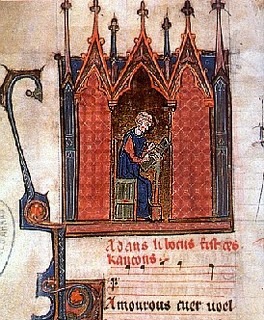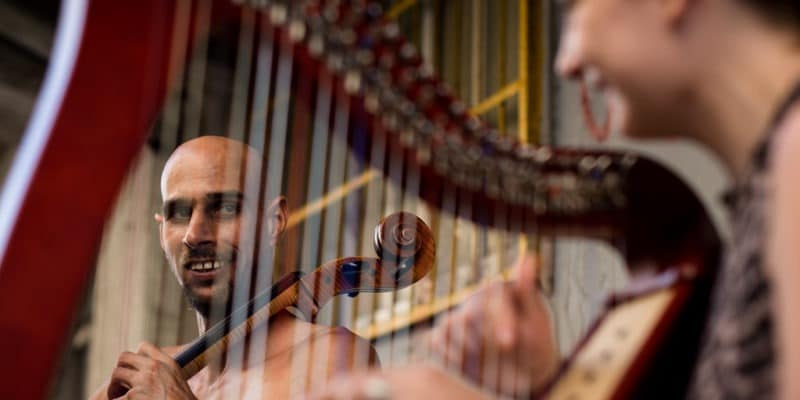In the 13th century, France, and Arras in particular, was experiencing a period of remarkable cultural growth and innovation. It was during this time that the earliest French poets and composers began experimenting with new forms of artistic expression, particularly through the development of polyphonic chansons and musical theater. This period of cultural flourishing produced many great artists, but none were as influential as Adam de la Halle, a celebrated composer, poet, and musician hailing from northern France.
Who was Adam de la Halle?
Adam de la Halle was born around 1237 in Arras, a city that would become central to his life and work. Coming from a privileged background as the son of a knight, he received an education that few of his contemporaries had the opportunity to pursue. His studies took him to the prestigious University of Paris, where he honed his talents in poetry and music. Adam de la Halle eventually made his way into the court of Artois, serving Count Robert II of Artois, and it was here that his genius began to flourish. His compositions spanned a wide range of forms, including chansons, ballades, and rondeaux written in the langue d’oïl, the vernacular language of northern France at the time. Additionally, he was known for his musical theater pieces, called “jeux-partis” and “sottes chansons,” which showcased his versatility and wit.

Robin and Marion’s game
Among the numerous works attributed to Adam de la Halle, his most famous is undoubtedly the musical “Le Jeu de Robin et Marion.” Written around 1283, this play holds a special place in the history of Western music as one of the earliest examples of musical theater. It tells the charming tale of a shepherd couple, Robin and Marion, set against the pastoral backdrop of medieval northern France. Written in the langue d’oïl, the language used by the people of Arras and the surrounding region, the play weaves together song, dance, and spoken dialogue in a way that was revolutionary for its time. “Le Jeu de Robin et Marion” was first performed at the Court of Artois, under the patronage of Count Robert II d’Artois, where it received widespread acclaim for its lively depiction of rural life and romance.
The music of “Le Jeu de Robin et Marion” is particularly remarkable. Adam de la Halle composed vibrant, joyful melodies that captured the simplicity and contentment of the shepherds’ lives. Accompanied by instruments such as the tambourine, drum, and fiddle, the songs conveyed a sense of lightheartedness and celebration. This work was not just entertainment; it reflected the social and cultural environment of medieval Arras, preserving a snapshot of the era’s traditions and values.
Party games and silly songs
Beyond “Le Jeu de Robin et Marion,” Adam de la Halle was a prolific creator of various forms of musical theater. His other compositions included “jeux-partis,” which were musical plays featuring debates, often between lovers, and “sottes chansons,” or silly songs, that used humor to tell absurd or whimsical stories. These works were immensely popular in medieval Arras and throughout France, offering a blend of wit and musical sophistication. The “jeux-partis” showcased his talent for crafting dialogues filled with clever repartee, while the “sottes chansons” provided lighthearted entertainment that resonated with audiences at feasts, banquets, and social gatherings. His music and poetry were so influential that they helped shape the medieval French cultural landscape, leaving a lasting legacy on future generations of composers and poets.
Other works by Adam de la Halle
Adam de la Halle’s genius is further evident in his other notable works, each reflecting a different facet of medieval life and thought. One such piece is “Le Jeu de la Feuillée”, a musical play written in the langue d’oïl. This three-act play explores the themes of love, cynicism, and romance through the story of two brothers, Gautier and Sarrasin, who embark on a quest to find a wife. The contrasting views of the brothers—one skeptical of women’s honesty, the other believing in the purity of true love—offer insight into medieval attitudes toward marriage and relationships. The blend of song and spoken dialogue in “Le Jeu de la Feuillée” exemplifies Adam de la Halle’s mastery in combining poetry, music, and drama.
Another of his well-known works is “Le Jeu de la Pastourelle”, a musical play that narrates the romantic pursuits of a knight who falls in love with a shepherdess. This play, which combines music, dance, and theater, serves as an early example of the musical comedy genre. It delves into themes of love, social class, and human nature, portraying the knight’s efforts to win the heart of the humble shepherdess despite the differences in their social status. The play’s music, with its lively songs and dances, evokes the emotions and atmosphere of the story, demonstrating Adam de la Halle’s ability to use music to enhance narrative and character development.
In contrast, “Le Jeu Adan” takes on a more serious tone, recounting the biblical story of Adam and Eve as described in the Book of Genesis. This play features a combination of spoken dialogues and songs, exploring deep religious themes such as creation, sin, and redemption. The use of music, particularly the melodies that reflect the story’s emotional shifts, illustrates the importance of musical elements in medieval theater. “Le Jeu Adan” is considered one of Adam de la Halle’s most significant works, showcasing his versatility in writing pieces that could be both serious and humorous.
The “Sottes chansons” (silly songs)
Sottes chansons were another genre in which Adam de la Halle excelled. These comic songs were characterized by their absurd and often satirical storytelling, written in the langue d’oïl and accompanied by catchy, straightforward melodies. The “Sottes chansons” highlight the humor and playful spirit of medieval society, offering a glimpse into the daily life and mindset of the time. Through these songs, Adam de la Halle demonstrated not only his poetic talent but also his keen understanding of the human condition, employing humor as a means to reflect on the joys and follies of life.
The end of Adam de la Halle’s life
Adam de la Halle spent much of his life in the service of the Artois court, particularly under Count Robert II of Artois. However, his later years took him far from his homeland. He traveled to Italy, entering the service of King Charles II d’Anjou, ruler of the Kingdom of Naples. It is believed that he died around 1288, likely in Naples. Although widely recognized in his time as a talented musician and poet, Adam de la Halle’s works fell into obscurity for centuries. It wasn’t until the late 19th century that his contributions to music and theater were rediscovered and appreciated once more.
The legacy of Adam de la Halle
The legacy of Adam de la Halle is monumental. He not only influenced the course of medieval music and theater in France but also laid the groundwork for the future development of musical theater as a genre. Adam de la Halle was a pioneer of polyphonic music, composing songs that incorporated complex harmonies and multiple voices. His integration of music with dance and drama created a close relationship between these art forms that continues to be significant in French culture today. Moreover, his poetic works, often imbued with humor and satire, captured the essence of daily life in medieval Arras. Without question, Adam de la Halle remains an iconic figure of Arras, a testament to the city’s rich cultural heritage. His work not only reflected the social and cultural dynamics of his era but also shaped the artistic practices that followed, cementing his place in the history of French music and theater.
Where is rue Adam de la Halle in Arras ?
Arras naturally named one of its streets after the poet, near the Stade Degouve Brabant, perpendicular to the Boulevard du Général De Gaulle. You’ll find it on this map :
And the middle school ?
There is also a college in Achicourt named after him (near the Tournesol swimming pool). Here’s the location, just south of Arras :
R.C.
